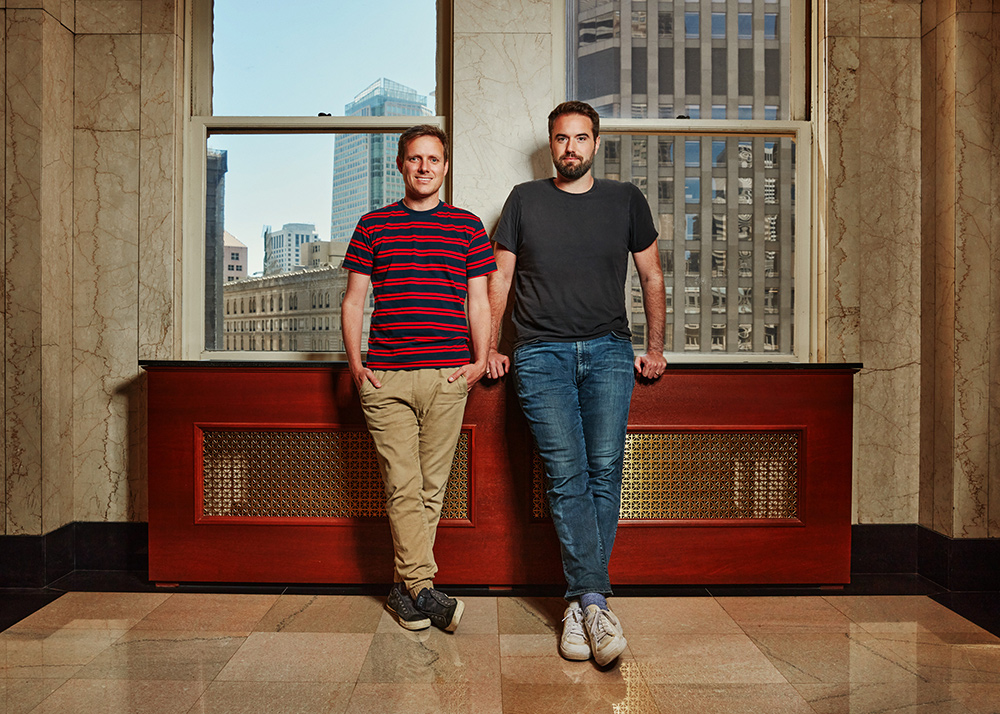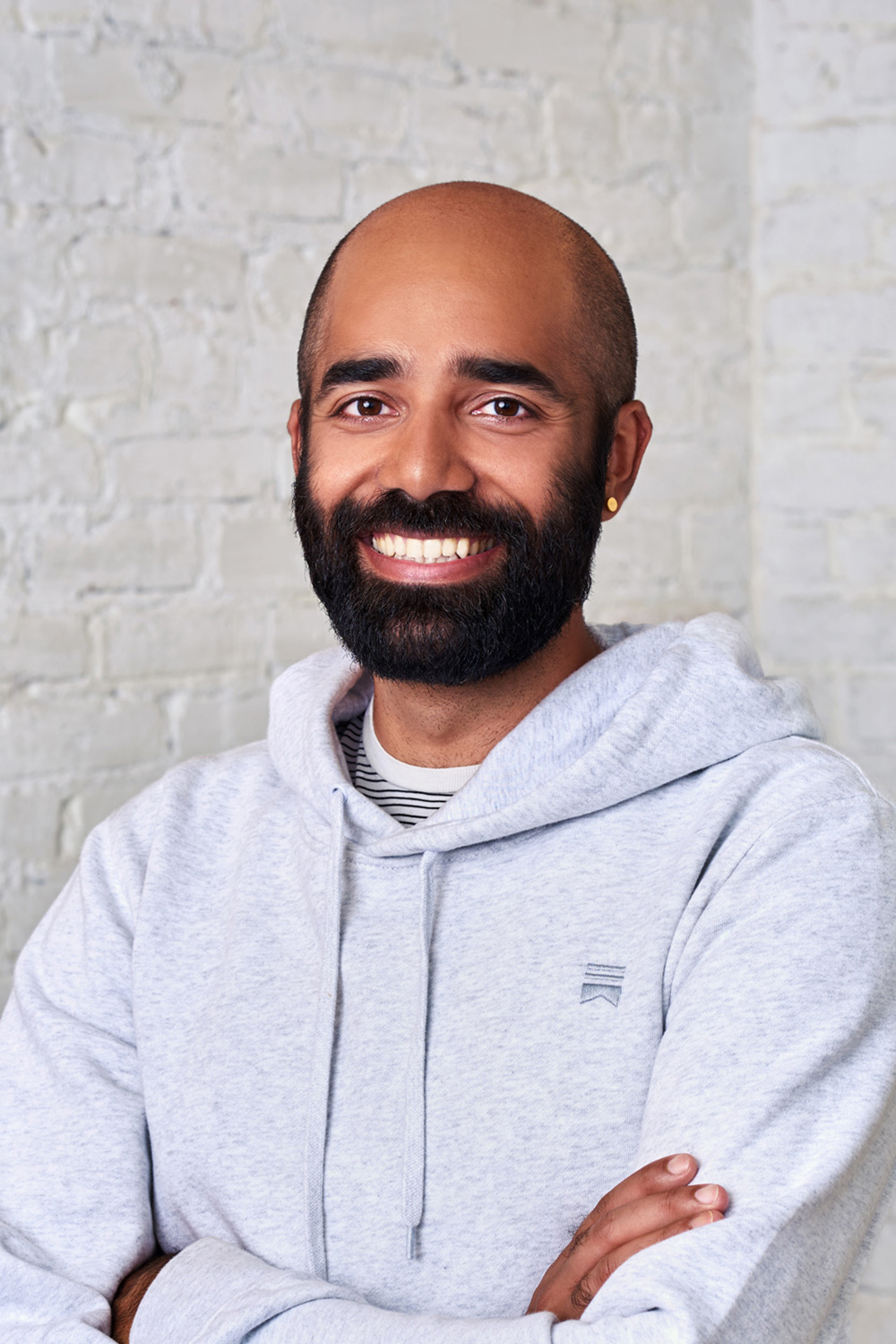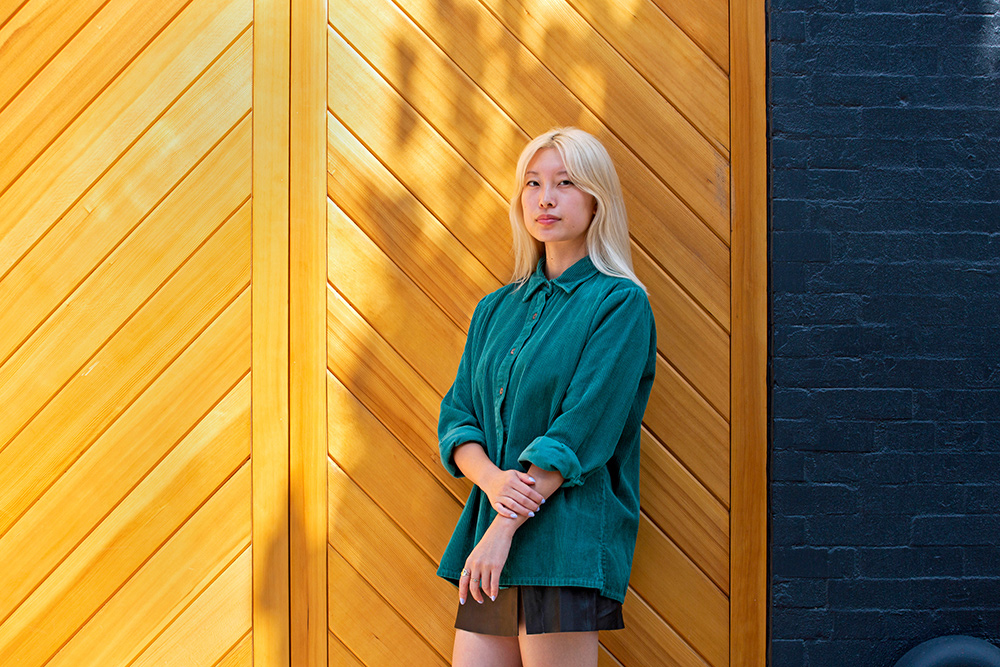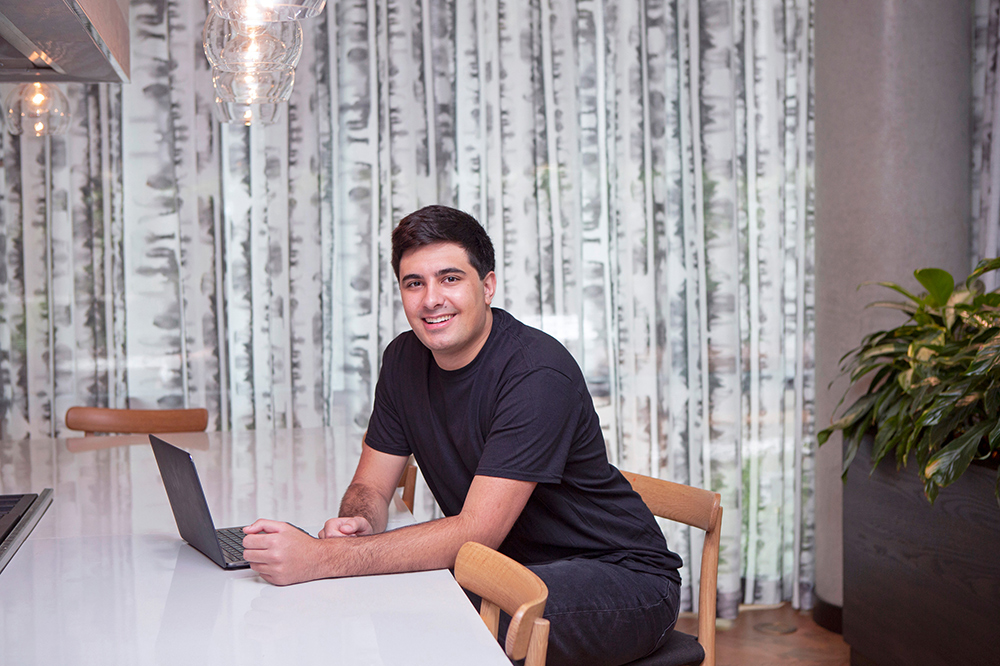这个平台能让你靠写作发财,背后的旧产业却在消亡
去年夏天,曾供职于《纽约客》(The New Yorker)和《芝加哥论坛报》(the Chicago Tribune)、60岁的作家艾米丽·纳恩住进了北卡州阿西娅郡的一个车库中。她原本去那是为了完成一本书作,最终却留了下来。她说:“我进入了归隐模式。当我回归现实时,我觉得‘自己岁数太大了,无法找到工作。’我没有接任何自由写作的活。面对当前这个全新的美食作家世界,要融入其中真的很难。我觉得,自己这回遇到了大麻烦。”
幸好这里还有沙拉。由于周边有着众多令人赞不绝口的农产品,“如同诺曼·洛克威尔(20世纪早期的重要画家及插画家-译注)画笔下的水果、蔬菜摊位和市场”,纳恩开始“将桃子、李子、浆果和西红柿等一切她喜欢的食物拌在一起,从来不去担心食物搭配的问题。这听起来非常俗套,我讨厌用这个词,应该说这种方法很有治愈效果。”她在Twitter上发布了自己的作品,美食作家雷根·弗雷切·史蒂芬斯以及女演员史密斯·卡梅隆鼓励她撰写新闻通讯。“我当时觉得,哈哈,很有意思。我应该试试。”
2020年10月,她确实干起了这一行,在Substack上创建了《沙拉杂烩部》(The Department of Salad)专栏。Substack是一个线上平台,能够让作者进行创作,并将作品直接发送给订阅用户。纳恩很快就一鸣惊人。一开始专栏文章是免费的,到了2021年2月,她引入了一个付费服务选项。到了3月底,公司注意到了这一点,并向纳恩提供了Substack Pro项目,其功能类似于新书预付金:也就是预先支付一年的定额费用,有时候是两年,这样,作者在发展其事业时还能继续生活。公司还会从订阅费中抽成15%。当项目到期后,这一比例将恢复至标准Substack合约的规定:作家将拿到近九成, Substack抽取一成,同时Stripe将获得3%的信用卡支付结算费。纳恩最近搬到了亚特兰大,但她并未透露其Pro合约的金额,不过她说“公司说的这个数字对我来说足够了,我感觉‘自己也没有其他的办法能够在一年内赚到这么多钱。’我有些不安,但还是接受了。”

Pro项目的要求并不多;纳恩觉得最有压力的要求之一是每周至少发两篇稿件(在其新闻通讯的免费阶段,她一周只需要发一篇稿子)。不过,Substack还会聘请一位她所挑选的编辑与其合作,并为其提供访问Getty Images的机会以及免费打字服务(每月限量)。她的订阅用户超过了1.5万人,收取5.5美元的月费或50美元的年费;Substack称,用户从免费到付费的转换率通常在5%-10%之间。她说:“我并没有年入百万美元,但收入感觉真的很稳定,与我在《芝加哥论坛报》的薪资相当,而且我当时并不少挣。这一点听起来依然真的很俗,但它多少让我回归了自己的写作老本行,而且我可以写我想写的东西。”
20年来,媒体格局一直在瓦解和衰落,而且对于大多数老媒体公司来说,一直困扰他们的一个无解难题在于:到底是花钱购买高质量的写作内容,还是购买谷歌算法转瞬即逝的点击诱饵。Substack是少数几家试图通过将作者与其愿意付费阅读的读者相连,来解决这一复杂局面的公司之一。从很多方面来看,这一举措正在奏效:Substack拥有50多万名愿意为通讯作者付费的订阅读者,还有数千万的免费读者。公司称,依据常见类别的收入和受众数量排行榜,平台上排名前十的作者每年能挣到2000万美元以上。
在当前媒体环境下,如此丰厚的报酬引发了人们对通过Substack赚钱的极大兴趣。然而,仅仅是因为一些订阅用户会向一些作者的内容付费,并不意味着所有人都能通过这个方式赚大钱(甚至以此为生计)。然后,当一家公司义无反顾地进入风投/科技领域,尝试颠覆老派媒体格局时,质疑声和无法避免的并发症将接踵而至,也为独立作者提供了在当前这个错误信息和虚假信息满天飞的时代进行自我创作的机会,正因为如此,要在这个领域找到一份拥有不俗薪资和健康福利的工作,其概率几乎不亚于中彩票。对于很多作者来说,Substack是危险水域的救命浮标;其他人认为,他们只不过是被扔进了深海领域,因为他们得尝试身兼数职,担任自己的抄写员、编辑、出版商、艺术总监和公关机器。然而,什么样的标准才能得到几乎所有人的认同?Substack正在改写写作的规则。
“衰败的”媒体
2017年,克里斯·贝斯特、哈米什·麦肯齐和杰拉吉·塞蒂共同创办了Substack,他们都曾在加拿大信息发送应用Kik共事,贝斯特亦是Kik的联合创始人之一。当时,贝斯特写了一篇文章,并分享给了当时作为特斯拉首席作者的科技记者麦肯齐。麦肯齐说:“这篇文章讲述了当前主流媒体衰败的状态,因为它所依赖的激励构架鼓励的是让人们分裂的行为和内容,而不是帮助他们开展合作,或朝着某种真实的想法开展工作。这篇贴文讲述了一个现实:对于社交媒体巨头来说,这并非是能够轻松解决的问题,无法靠算法调整来解决。”
麦肯齐对贝斯特说,这篇文章很好,但媒体圈所有人对这个问题都是心知肚明。何不尝试想想解决办法呢?
随后又出现了另一篇文章,发布于新设想的平台Substack。麦肯齐说:“它有点类似于我们的宣言,为如何打造这个美好的世界指明了方向。在这个世界中,作者们可以通过真正实现互联网的力量,即帮助作者和读者直接互连来改变激励构架,而不是受制于注意力经济的恶意力量,来不断发展壮大。解决方法必然是读者给他们信任的作者付费,而且不仅仅是稿费,同时还有订阅费用,因为订阅为作者提供了一种可持续、源源不断的收入来源。”
当然,Substack(“订阅+堆栈”,因为它是一个包罗万象的堆栈,包含了人们需要的一切内容)并没有推出订阅模式,也没有打造老掉牙的通讯栏目(在采访中,麦肯齐和公司的其他人认为,他们更喜欢“刊物”而不是“通讯”),但该公司确实让传统媒体陷入了一丝慌乱。传统媒体本来就已经因为广告模式的终结以及充斥当地和国际新闻的裁员而叫苦不迭,同时也面临着发行量下降、广泛的错误信息以及阴谋论活动,以及记者队伍持续、大量的衰退。对于作者来说,Substack有一项内容非常吸引人:拥有自身内容的版权以及关系网,而且在决定离开公司时你可以带走一切。
很明显,这种模式对读者也有好处。最受欢迎的Substack作者包括波士顿大学历史学教授希瑟·科克斯·理查德森,专栏《来自于一名美国人的信件》( Letters From an American);威利·吴,专栏《比特币走向预测》(The Bitcoin Forecast);以及作者兼调查记者马特·泰比,专栏《TK新闻》(TK News)。其他顶级作者(排名经常变化)包括亨特·哈里斯、安德鲁·苏利文、贾德·勒格姆、巴里·韦斯、迈克尔·摩尔、凯西·牛顿和莱尼·拉奇斯基。高调的Substack Pro合约之间也存在着巨大的金额差距,例如前Vox撰稿人马修·伊格莱西亚斯新闻通讯《缓慢的无聊》(Slow Boring)合约(25万美元外加15%的订阅费收入;作者说,如果没有Pro合约的话会赚的更多)。萨尔曼·鲁什迪在9月公布了自己的Pro合约,他向《纽约时报》(the New York Times)透露,其金额要远低于卖书的收入,他只是想“尝试下从未做过的事情。”对于那些并非伊格莱西亚斯和鲁什迪这类名人的作者,麦肯齐说:“在我看来,有不少人的收入还算可以。”
Substack的首席技术官杰拉吉·塞蒂还记得,一开始,这家企业的经营模式非常简单,这三位联合创始人围坐在贝斯特公寓的桌子旁。他说:“有一张经典的照片记录了我们完成首轮融资的情景:大家都光着脚聚在一起,还有克里斯的狗凯西。这种状况持续了大概一整年。”公司成立之时将比尔·毕夏普的作品《中国主义》(Sinocism)作为首刊,很快便赚到了钱。这是一部关于中国的通讯,已经写了5年,一直处于免费状态。麦肯齐说,他们原本可以将其打造为一项“新潮业务”,而且无需为此筹资,但在2017年,The Toast创始人丹尼·拉弗瑞开始撰写通讯《The Shatner Chatner》(如今更名为《The Chatner》)。拉弗瑞的读者群与毕夏普的迥然不同,这一点让这些创始人感到万分诧异,因为毕夏普的读者可以用企业信用卡来支付订阅费,并将其当做工作开支。麦肯齐说,“丹尼的受众就像是中西部地区的图书馆管理员,自己掏腰包支付每月5美元或每年50美元的费用。由于这些使用案例完全没有可比性,我们觉得,这一现象真的可能是特例。”(拉弗瑞的Pro合约已经得到了广泛公开,两年43万美元。)

这几位创始人申请了初创加速器Y Combinator,并获得了通过,随后筹集到了8250万美元。传播副总裁梅瑟维·程称,在2021年完成了风投公司安德森·霍洛维茨 (Andreessen Horowitz)领投的B轮融资之后,Substack当前的估值达到了6.5亿美元,其员工数从去年这个时候的15名增至75名,“而且每周都在增长”。 梅瑟维还指出,其中有20名员工属于合作者,他们为作者提供支持,并帮助其组建社群。公司在旧金山的新总部正处于建设当中。他们已经招募了一批知名作家,引入了网播功能,并决定“押注漫画作者”,同时还为作者创建了法律保护计划。公司设立了Substack成长计划,手把手地教授创作者们如何发展其受众群;公司还创建了助学金和拨款项目,告诉作者如何从零做起;公司还设立了“Substack Local”这个“100万美元的动议,通过帮助独立作者以订阅的方式,打造当地新闻刊物,从而培养和开发当地新闻生态系统”。10月1日,公司宣布了“留任作者”计划,以发现那些正在打造其自有Substack内容的创作者,并允许读者和作者群体在这一过程中分享其洞见。在过去的5个月中,公司还收购了三家公司:制定社群打造策略的People & Co.、公众通信初创企业Letter以及最近的Cocoon团队,Cocoon是一家订阅模式的社交网络公司,将继续保持独立营。

尽管公司还制定了其他很多计划,但其背后的理念十分简单:为作者扫清障碍,让他们无需为“会计、网站建设和设计标志以及所有费神、消耗创作力的事情操心”,梅瑟维说道,但也明确表示,并非所有的Pro合约都包含财务担保条款。“我们耗费了更多的精力来打造我们所提供的服务。之所以能有魔法般的效果,是因为我们有相关的技术,技术支持,针对读者的客户支持,还有编辑和医疗保险等服务(公司会为平台上一些尤为活跃的作者提供这方面的补助),以及法律保护和制作。此外,公司还有作者群体。作者只需要专注于写作,并提供高质量的作品。”
团队希望,作者的入住将带动整个出版经济的发展,因为作者(而且有时候是Substack)会聘请编辑、设计师、营销人员、制作者和出版商帮助打造其已完成的作品。事实上,这一现象正在发生。在1月,作家罗克珊·盖伊在Substack上推出了专栏《大言不惭》(The Audacity),她在这平台上发布新贵作者的文章(并向其付费),同时也会举办读书俱乐部。经营Popular Information的ThinkProgress创始人贾德·勒格姆有一个两人团队(一名作者,一名研究员)。前Buzzfeed作者安妮·海伦·彼得森(撰写《文化调查》,拥有5.6万名订阅用户)会向特约撰稿人支付500美元/篇的报酬,同时还聘请了插画设计师和专栏作家。
梅瑟维说:“除了通讯作者之外,这些人都是出版经济的一部分,依靠这些直接聘用关系来赚钱。他们就像是一个实体公司。有点类似于文艺复兴,很多人都可以通过写作来过上好日子。我们的确看到了一条能够让公司盈利的康庄大道,而且不仅仅是赚钱,同时还能打造一项真正有着重要意义的业务。我们希望继续打造这个充满了活力的生态系统。”
反弹
虽然Substack诞生未久,但由于其特点正对作者和读者群体的胃口,因此能够迅速收获如此巨大的媒体影响力倒也不足为奇。从《大西洋月刊》(The Atlantic)到《纽约客》,再到《纽约时报》,各大媒体对该平台议论颇多,有人将其描述为“对民主的潜在威胁”,也有人说“该平台令人不安”,有人称其为“骗局”,也有人对该平台大加申斥,指责其在与错误信息和仇恨言论的斗争中未能表明立场,有人对其究竟是“平台”还是“出版物”以及应当承担何种责任提出了质疑,有人对其“平台化运营”、与反跨性别或观点偏执的人士签定Pro合约的做法提出批评。受今年三月反弹事件的影响,许多知名作者已退出该平台,时至今日,相关问题仍未得到完全澄清。
Substack向来以内容审核宽松闻名,仅对骚扰、暴力威胁、人肉搜索和色情相关内容的发布作出了禁止,用麦肯齐的话说,平台一贯“坚决支持新闻自由,审查方面则以不干涉为原则”。梅瑟维表示:“当前,我们并未制订有关信息是否存在误导的判定标准。我们并不认为自己可以在互联网上扮演裁判的角色,去判断信息的真伪,也不认为自己可以对他人行为是否正确加以审查。但我们绝不会奖励因愤怒而诉诸暴力的行径,在这方面我们非常坚决。”
从直觉上看,该公司的创始人或将面临很大压力,被迫驱逐部分最具争议的作者(这些人可能也没有签定Pro合约)。Substack将是否公开相关合作的权利交给了撰稿人,不过这种做法也带来了一些困惑。无论如何,这些作者毕竟为Substack赚到了很多钱。麦肯齐表示,就Pro合约而言,“对我们来说,最重要的是我们不会谋求获得文章的所有权。整个合作更像是银行对贷款质量进行评估,而非出版商试图将自己的作品推向世界。”
除了肯定会有很多品行不端之人能够拿到银行贷款之外,还有一个涉及面更广的问题,那就是,在这个日益政治化的时代,该平台能否真正对政治事务保持怀疑态度,从道德上来说,企业也有义务对此划定界限。拉斯蒂·福斯特近来一直在网络上公开批评Substack的创始人,福斯特认为,Substack应在被资助人名单方面做到更加公开透明。虽然近来这方面的情况有所好转,但问题仍未完全解决。他表示:“格雷厄姆·莱因汉(因发表恐跨性别言论在Twitter遭禁)不应出现在这个平台之上,把他驱逐出去对平台不会有任何坏处”。2013年底至2016年,拉斯蒂·福斯特在TinyLetter网站上撰写的《Today in Tabs》曾风靡一时, 2020年该专栏在Substack重新上线后已获得25,000名订阅用户。
当然,离开也未尝不是一种选择。今年6月,Facebook发布了自己旗下的自由撰稿人平台——Bulletin,Twitter旗下也有自营通讯专栏服务——Revue。彼得森说:“(市场上)还有很多其他选择。我觉得我们对平台说不上有什么品牌忠诚度,这是一种积极现象。”10月1日,气象学家兼气候记者埃里克·霍特豪斯向其近50万Twitter粉丝宣布:“我与Substack的合同已于昨日到期。今天,我将正式离开该平台。Substack拒绝对其平台上有关性别、新冠和气候的有害言论加以管控。我认为,当既有问题不断侵蚀我们的生活时,我们不应选择默然接受。”不过虽然有人选择离开Substack,加入Ghost、Buttondown或者甚至Medium,但想要加入或者留在Substack的人似乎更多。福斯特说:“如果能走的话我可能早就走了,不过其他平台也都有我不能接受的问题。”
一个人的战斗
从新闻学院毕业后,28岁的迪莉娅·蔡获得了大西洋传媒(Atlantic Media)的研究员职位,从事战略研究工作,主要负责跟进媒体趋势及“阅读大量有关尼曼实验室(Nieman Lab)的文章”。因为想找个地方分享自己的观点,她从2016年开始在TinyLetter上撰写专栏,并于2018年将自己的专栏搬到了Substack上。从2020年6月到2021年6月,尽管迪莉娅从未对Deez Links(每周记录媒体及相关行业发生的新鲜事)收取费用,但她还是通过在该栏目运营媒体分类广告赚到了2万美元。(Substack的创始人可能不喜欢广告这种商业模式,但没人规定撰稿人不能通过广告赚钱。)
今年夏天,看到Substack一波接一波地发布Pro签约公告,迪莉娅怀疑自己是不是错过了大好机遇。“我觉得自己有点像个傻瓜,因为狂热的‘淘金热’似乎正在上演。也许我真的可以像其他作者一样,走出去为自己打拼一下。不过我并没有幻想过为自己工作,过那种整天待在家里码字的生活。我喜欢在公司上班,也很享受和同事一块工作的感觉,我还有很多要学的东西。一直以来,我只是希望通过这个栏目找到一份很有意思的编辑工作。”迪莉娅也确实通过撰写通讯实现了自己的心愿,如今,她已经成为《名利场》(Vanity Fair)的撰稿人,在通过Deez Links透露其正在撰写《中心地带》(Central Places)后,最近这本小说也已成功卖出。
今年7月初,迪莉娅停更了自己拥有近11500名订阅用户的通讯专栏,但新的订阅者还在继续涌入。最近一个周日,她发现自己忽然又有了继续更新下去的想法。迪莉娅说:“你知道,这种写作感觉颇为不同。我肯定不能像从事这份工作之前那样频繁地更新这个专栏,不过我也非常清楚,这里的每一位订阅用户都是我个人的读者,因而极具价值。为了做到完全透明,我正努力在明年秋天再出一本书。”

迪莉娅认为,Substack和其他通讯专栏平台共同的优点在于,它能让读者获得成为某人主顾、进入其思想核心圈的那种满足感。读者甚至可以直接跟作者辩论。但我们的脑子里能同时容纳多少种声音呢?或者说我们的收件箱里能容纳多少封时事通讯?信用卡又能支付起多少费用呢?最近有位朋友跟我抱怨说,为了支持其他朋友,她的订阅已经让自己不堪重负。她不仅没时间读完自己订阅的内容,连订阅费也已经付不起了。但她又担心自己一旦取消订阅又会被朋友们发现。最后,她还是取消了一些订阅服务,并写信对个中缘由做出了解释。她想:“如果我们继续这么做,难道我们要把自己从Substack赚的所有钱都拿去支持Substack上的其他作者么?”(10%的订阅费会直接进入Substack的账户。)
迪莉娅说:“艺术和金钱的联系空前紧密。从某些方面来说,这种感觉非常美妙,因为支持你的人正是你的读者,但这也会让你产生一种做交易的感觉。只有你自己在为自己作品的价值背书。可能这也是我不愿全职做这项工作的原因所在。我感觉自己真的做不到‘王婆卖瓜,自卖自夸’。”
淘金热
23岁的埃德温·多尔西已经赚了大钱。作为一名斯坦福大学的学生,他在大四快结束时开始在Substack上写作。他说:“我从幼时就对股票充满热情,大四学期末,我一直在找工作。面试了很多家公司,但是都没有找到自己心仪的岗位”。受《请愿书》(Petition)(该文聚焦“颠覆始于被颠覆者的优势”)等发表于Substack的文章启发,他从2020年2月开始撰写自己的专栏,并将其命名为“熊洞”(The Bear Cave)。他解释道:“那时,我每周都会发出免费的通讯邮件,分享做空信息、企业近期不端行径以及SEC可能发起哪些调查等内容。”同年9月,他搬出了父母的房子,来到纽约,开始收取每月34美元(或每年340美元)的“深度调查”费用,并对那些具有误导性或伤害客户的企业进行曝光。开始收费一周之后,他的年度经常性收入便达到了6万美元,两个月后,又进一步提升到了10万美元。这时,Substack联系了他,除了祝贺他的快速成长,也向他询问了成功的秘诀。
开始收费9个月后,多尔西的年收入达到了33万美元,在Substack扣除10%佣金、信用卡扣除3%手续费后,大约到手29万美元。他说,订阅用户增长较快时,一个月就可以增长20%左右。“老实说,这是大家梦寐以求的工作,对年轻人来说更是如此。因为我可以睡懒觉,可以自己选择工作时间。如果算核心词的话,那么我每个词都能赚15美元,这简直是天方夜谭。”

而要达成如此傲人的成绩,就少不了Substack Grow之类项目的帮助。最近一个星期三,188名申请者获准参加“独立撰稿人速成班”,了解如何打造忠实读者群、启动付费订阅项目,他们通过Zoom会议了解了成为Substack上成功撰稿人所应具备的基本知识”。参与者被要求参加一场线上对话,分享自己个人成长中的重要时刻。活动中,主办方宣布举办“协助编辑”抽奖活动。此后,《前1000名客户》(First 1000,介绍了创始人如何获得自己的前1000名客户)的作者阿里·阿布拉塔分享了自己对如何在Substack上获取订阅用户的建议。188名满怀憧憬的参与者观看了本次直播,并认真记了笔记。
在寻找Substack不足之处的过程中,我们发现:为人们提供指导,引导其扩充订阅用户(只要达到建议与专业服务之间的某个甜蜜点即可)比将其培养成更优秀的作者要容易得多。Substack的模式屡遭批评,有些顶级作家在来到Substack的平台前已拥有多年经验,且拥有成熟的付费读者群体,有些则只是听说了Substack的存在后想过来试试手。(结果后者可能一年也能赚到30万美元。)
“大多数人都在苦苦挣扎,”乌里·布拉姆如是说。在发现非营利性的开源平台——Ghost的经济性更好、适应性更强之后,他将自己经营了12年之久、拥有超过74,000名读者的通讯栏目《浏览》(Browser)从Substack搬到了Ghost上。布拉姆说:“我认为,即便只是使用默认设置,甚至在还没完全适应时,Ghost也比Substack好用。”他认为,Substack的成功故事有些言过其实。“大多数通讯专栏做得都不好。他们的读者较少,想要实现增长也很难。即便历经千辛万苦、做出种种尝试之后,可能还是行不通。(之所以很少听到这种声音,)只是因为那些做得不好的人可能不会大肆声张而已,谁会到处说:‘我每天都泡在Substack上,结果我的专栏每月才只能赚到600美元’?这还不算退出费用,如果你想退出Substack,就得给所有订阅用户退钱,这笔费用可能相当于你半年的收入。”
安妮·特鲁贝克是独立出版社Belt Publishing的创始人兼出版商,她经营的Substack专栏名为“小出版社笔记”(Notes From a Small Press),收入约2500美元。她有大约3000名订阅用户,其中大约10%为付费用户。不过因为这个专栏对她来说只是副业,所以其规模和额外带来的收益对她而言都可以接受。令她感兴趣的是,人们确实会付钱,她也很想知道这种新生事物会对整个出版界产生何种影响。相较于Substack的兴起对整个经济的影响,该平台能否持续或许并没有那么重要。她说:“我认为,有些地方肯定在考虑自己的收费标准和人员配备,因为作者正在流失。任何增加作者收入的做法都会产生深远影响。我认为,这将带来一些其它的想法,我们将会看到事情将如何发展。”
迪莉娅表示:“这种向订阅模式的转型是一种积极变化,对新闻行业而言,过去,广告商永远是那么高高在上,而现在无论是在二者之间进行选择,还是找到合适的组合,都是一件大大的好事。”但她确实也对当前通讯专栏热潮中的暴富元素感到疑惑。她说:“首先,如果你想赚钱,肯定要花很长时间。其次,除了金钱以外,做这件事的理由还有很多。”
彼得森对此表示赞同。她说:“我做这件事从来都不是为了赚大钱。这个行业变化无常,对此我们非常清楚。我只是想获得一些对自己未来的掌控,让自己有那么一会儿可以不用纠结。这种感觉很棒。”(财富中文网)
译者:梁宇
审校:夏林
去年夏天,曾供职于《纽约客》(The New Yorker)和《芝加哥论坛报》(the Chicago Tribune)、60岁的作家艾米丽·纳恩住进了北卡州阿西娅郡的一个车库中。她原本去那是为了完成一本书作,最终却留了下来。她说:“我进入了归隐模式。当我回归现实时,我觉得‘自己岁数太大了,无法找到工作。’我没有接任何自由写作的活。面对当前这个全新的美食作家世界,要融入其中真的很难。我觉得,自己这回遇到了大麻烦。”
幸好这里还有沙拉。由于周边有着众多令人赞不绝口的农产品,“如同诺曼·洛克威尔(20世纪早期的重要画家及插画家-译注)画笔下的水果、蔬菜摊位和市场”,纳恩开始“将桃子、李子、浆果和西红柿等一切她喜欢的食物拌在一起,从来不去担心食物搭配的问题。这听起来非常俗套,我讨厌用这个词,应该说这种方法很有治愈效果。”她在Twitter上发布了自己的作品,美食作家雷根·弗雷切·史蒂芬斯以及女演员史密斯·卡梅隆鼓励她撰写新闻通讯。“我当时觉得,哈哈,很有意思。我应该试试。”
2020年10月,她确实干起了这一行,在Substack上创建了《沙拉杂烩部》(The Department of Salad)专栏。Substack是一个线上平台,能够让作者进行创作,并将作品直接发送给订阅用户。纳恩很快就一鸣惊人。一开始专栏文章是免费的,到了2021年2月,她引入了一个付费服务选项。到了3月底,公司注意到了这一点,并向纳恩提供了Substack Pro项目,其功能类似于新书预付金:也就是预先支付一年的定额费用,有时候是两年,这样,作者在发展其事业时还能继续生活。公司还会从订阅费中抽成15%。当项目到期后,这一比例将恢复至标准Substack合约的规定:作家将拿到近九成, Substack抽取一成,同时Stripe将获得3%的信用卡支付结算费。纳恩最近搬到了亚特兰大,但她并未透露其Pro合约的金额,不过她说“公司说的这个数字对我来说足够了,我感觉‘自己也没有其他的办法能够在一年内赚到这么多钱。’我有些不安,但还是接受了。”
Pro项目的要求并不多;纳恩觉得最有压力的要求之一是每周至少发两篇稿件(在其新闻通讯的免费阶段,她一周只需要发一篇稿子)。不过,Substack还会聘请一位她所挑选的编辑与其合作,并为其提供访问Getty Images的机会以及免费打字服务(每月限量)。她的订阅用户超过了1.5万人,收取5.5美元的月费或50美元的年费;Substack称,用户从免费到付费的转换率通常在5%-10%之间。她说:“我并没有年入百万美元,但收入感觉真的很稳定,与我在《芝加哥论坛报》的薪资相当,而且我当时并不少挣。这一点听起来依然真的很俗,但它多少让我回归了自己的写作老本行,而且我可以写我想写的东西。”
20年来,媒体格局一直在瓦解和衰落,而且对于大多数老媒体公司来说,一直困扰他们的一个无解难题在于:到底是花钱购买高质量的写作内容,还是购买谷歌算法转瞬即逝的点击诱饵。Substack是少数几家试图通过将作者与其愿意付费阅读的读者相连,来解决这一复杂局面的公司之一。从很多方面来看,这一举措正在奏效:Substack拥有50多万名愿意为通讯作者付费的订阅读者,还有数千万的免费读者。公司称,依据常见类别的收入和受众数量排行榜,平台上排名前十的作者每年能挣到2000万美元以上。
在当前媒体环境下,如此丰厚的报酬引发了人们对通过Substack赚钱的极大兴趣。然而,仅仅是因为一些订阅用户会向一些作者的内容付费,并不意味着所有人都能通过这个方式赚大钱(甚至以此为生计)。然后,当一家公司义无反顾地进入风投/科技领域,尝试颠覆老派媒体格局时,质疑声和无法避免的并发症将接踵而至,也为独立作者提供了在当前这个错误信息和虚假信息满天飞的时代进行自我创作的机会,正因为如此,要在这个领域找到一份拥有不俗薪资和健康福利的工作,其概率几乎不亚于中彩票。对于很多作者来说,Substack是危险水域的救命浮标;其他人认为,他们只不过是被扔进了深海领域,因为他们得尝试身兼数职,担任自己的抄写员、编辑、出版商、艺术总监和公关机器。然而,什么样的标准才能得到几乎所有人的认同?Substack正在改写写作的规则。
“衰败的”媒体
2017年,克里斯·贝斯特、哈米什·麦肯齐和杰拉吉·塞蒂共同创办了Substack,他们都曾在加拿大信息发送应用Kik共事,贝斯特亦是Kik的联合创始人之一。当时,贝斯特写了一篇文章,并分享给了当时作为特斯拉首席作者的科技记者麦肯齐。麦肯齐说:“这篇文章讲述了当前主流媒体衰败的状态,因为它所依赖的激励构架鼓励的是让人们分裂的行为和内容,而不是帮助他们开展合作,或朝着某种真实的想法开展工作。这篇贴文讲述了一个现实:对于社交媒体巨头来说,这并非是能够轻松解决的问题,无法靠算法调整来解决。”
麦肯齐对贝斯特说,这篇文章很好,但媒体圈所有人对这个问题都是心知肚明。何不尝试想想解决办法呢?
随后又出现了另一篇文章,发布于新设想的平台Substack。麦肯齐说:“它有点类似于我们的宣言,为如何打造这个美好的世界指明了方向。在这个世界中,作者们可以通过真正实现互联网的力量,即帮助作者和读者直接互连来改变激励构架,而不是受制于注意力经济的恶意力量,来不断发展壮大。解决方法必然是读者给他们信任的作者付费,而且不仅仅是稿费,同时还有订阅费用,因为订阅为作者提供了一种可持续、源源不断的收入来源。”
当然,Substack(“订阅+堆栈”,因为它是一个包罗万象的堆栈,包含了人们需要的一切内容)并没有推出订阅模式,也没有打造老掉牙的通讯栏目(在采访中,麦肯齐和公司的其他人认为,他们更喜欢“刊物”而不是“通讯”),但该公司确实让传统媒体陷入了一丝慌乱。传统媒体本来就已经因为广告模式的终结以及充斥当地和国际新闻的裁员而叫苦不迭,同时也面临着发行量下降、广泛的错误信息以及阴谋论活动,以及记者队伍持续、大量的衰退。对于作者来说,Substack有一项内容非常吸引人:拥有自身内容的版权以及关系网,而且在决定离开公司时你可以带走一切。
很明显,这种模式对读者也有好处。最受欢迎的Substack作者包括波士顿大学历史学教授希瑟·科克斯·理查德森,专栏《来自于一名美国人的信件》( Letters From an American);威利·吴,专栏《比特币走向预测》(The Bitcoin Forecast);以及作者兼调查记者马特·泰比,专栏《TK新闻》(TK News)。其他顶级作者(排名经常变化)包括亨特·哈里斯、安德鲁·苏利文、贾德·勒格姆、巴里·韦斯、迈克尔·摩尔、凯西·牛顿和莱尼·拉奇斯基。高调的Substack Pro合约之间也存在着巨大的金额差距,例如前Vox撰稿人马修·伊格莱西亚斯新闻通讯《缓慢的无聊》(Slow Boring)合约(25万美元外加15%的订阅费收入;作者说,如果没有Pro合约的话会赚的更多)。萨尔曼·鲁什迪在9月公布了自己的Pro合约,他向《纽约时报》(the New York Times)透露,其金额要远低于卖书的收入,他只是想“尝试下从未做过的事情。”对于那些并非伊格莱西亚斯和鲁什迪这类名人的作者,麦肯齐说:“在我看来,有不少人的收入还算可以。”
Substack的首席技术官杰拉吉·塞蒂还记得,一开始,这家企业的经营模式非常简单,这三位联合创始人围坐在贝斯特公寓的桌子旁。他说:“有一张经典的照片记录了我们完成首轮融资的情景:大家都光着脚聚在一起,还有克里斯的狗凯西。这种状况持续了大概一整年。”公司成立之时将比尔·毕夏普的作品《中国主义》(Sinocism)作为首刊,很快便赚到了钱。这是一部关于中国的通讯,已经写了5年,一直处于免费状态。麦肯齐说,他们原本可以将其打造为一项“新潮业务”,而且无需为此筹资,但在2017年,The Toast创始人丹尼·拉弗瑞开始撰写通讯《The Shatner Chatner》(如今更名为《The Chatner》)。拉弗瑞的读者群与毕夏普的迥然不同,这一点让这些创始人感到万分诧异,因为毕夏普的读者可以用企业信用卡来支付订阅费,并将其当做工作开支。麦肯齐说,“丹尼的受众就像是中西部地区的图书馆管理员,自己掏腰包支付每月5美元或每年50美元的费用。由于这些使用案例完全没有可比性,我们觉得,这一现象真的可能是特例。”(拉弗瑞的Pro合约已经得到了广泛公开,两年43万美元。)
这几位创始人申请了初创加速器Y Combinator,并获得了通过,随后筹集到了8250万美元。传播副总裁梅瑟维·程称,在2021年完成了风投公司安德森·霍洛维茨 (Andreessen Horowitz)领投的B轮融资之后,Substack当前的估值达到了6.5亿美元,其员工数从去年这个时候的15名增至75名,“而且每周都在增长”。 梅瑟维还指出,其中有20名员工属于合作者,他们为作者提供支持,并帮助其组建社群。公司在旧金山的新总部正处于建设当中。他们已经招募了一批知名作家,引入了网播功能,并决定“押注漫画作者”,同时还为作者创建了法律保护计划。公司设立了Substack成长计划,手把手地教授创作者们如何发展其受众群;公司还创建了助学金和拨款项目,告诉作者如何从零做起;公司还设立了“Substack Local”这个“100万美元的动议,通过帮助独立作者以订阅的方式,打造当地新闻刊物,从而培养和开发当地新闻生态系统”。10月1日,公司宣布了“留任作者”计划,以发现那些正在打造其自有Substack内容的创作者,并允许读者和作者群体在这一过程中分享其洞见。在过去的5个月中,公司还收购了三家公司:制定社群打造策略的People & Co.、公众通信初创企业Letter以及最近的Cocoon团队,Cocoon是一家订阅模式的社交网络公司,将继续保持独立营。
尽管公司还制定了其他很多计划,但其背后的理念十分简单:为作者扫清障碍,让他们无需为“会计、网站建设和设计标志以及所有费神、消耗创作力的事情操心”,梅瑟维说道,但也明确表示,并非所有的Pro合约都包含财务担保条款。“我们耗费了更多的精力来打造我们所提供的服务。之所以能有魔法般的效果,是因为我们有相关的技术,技术支持,针对读者的客户支持,还有编辑和医疗保险等服务(公司会为平台上一些尤为活跃的作者提供这方面的补助),以及法律保护和制作。此外,公司还有作者群体。作者只需要专注于写作,并提供高质量的作品。”
团队希望,作者的入住将带动整个出版经济的发展,因为作者(而且有时候是Substack)会聘请编辑、设计师、营销人员、制作者和出版商帮助打造其已完成的作品。事实上,这一现象正在发生。在1月,作家罗克珊·盖伊在Substack上推出了专栏《大言不惭》(The Audacity),她在这平台上发布新贵作者的文章(并向其付费),同时也会举办读书俱乐部。经营Popular Information的ThinkProgress创始人贾德·勒格姆有一个两人团队(一名作者,一名研究员)。前Buzzfeed作者安妮·海伦·彼得森(撰写《文化调查》,拥有5.6万名订阅用户)会向特约撰稿人支付500美元/篇的报酬,同时还聘请了插画设计师和专栏作家。
梅瑟维说:“除了通讯作者之外,这些人都是出版经济的一部分,依靠这些直接聘用关系来赚钱。他们就像是一个实体公司。有点类似于文艺复兴,很多人都可以通过写作来过上好日子。我们的确看到了一条能够让公司盈利的康庄大道,而且不仅仅是赚钱,同时还能打造一项真正有着重要意义的业务。我们希望继续打造这个充满了活力的生态系统。”
反弹
虽然Substack诞生未久,但由于其特点正对作者和读者群体的胃口,因此能够迅速收获如此巨大的媒体影响力倒也不足为奇。从《大西洋月刊》(The Atlantic)到《纽约客》,再到《纽约时报》,各大媒体对该平台议论颇多,有人将其描述为“对民主的潜在威胁”,也有人说“该平台令人不安”,有人称其为“骗局”,也有人对该平台大加申斥,指责其在与错误信息和仇恨言论的斗争中未能表明立场,有人对其究竟是“平台”还是“出版物”以及应当承担何种责任提出了质疑,有人对其“平台化运营”、与反跨性别或观点偏执的人士签定Pro合约的做法提出批评。受今年三月反弹事件的影响,许多知名作者已退出该平台,时至今日,相关问题仍未得到完全澄清。
Substack向来以内容审核宽松闻名,仅对骚扰、暴力威胁、人肉搜索和色情相关内容的发布作出了禁止,用麦肯齐的话说,平台一贯“坚决支持新闻自由,审查方面则以不干涉为原则”。梅瑟维表示:“当前,我们并未制订有关信息是否存在误导的判定标准。我们并不认为自己可以在互联网上扮演裁判的角色,去判断信息的真伪,也不认为自己可以对他人行为是否正确加以审查。但我们绝不会奖励因愤怒而诉诸暴力的行径,在这方面我们非常坚决。”
从直觉上看,该公司的创始人或将面临很大压力,被迫驱逐部分最具争议的作者(这些人可能也没有签定Pro合约)。Substack将是否公开相关合作的权利交给了撰稿人,不过这种做法也带来了一些困惑。无论如何,这些作者毕竟为Substack赚到了很多钱。麦肯齐表示,就Pro合约而言,“对我们来说,最重要的是我们不会谋求获得文章的所有权。整个合作更像是银行对贷款质量进行评估,而非出版商试图将自己的作品推向世界。”
除了肯定会有很多品行不端之人能够拿到银行贷款之外,还有一个涉及面更广的问题,那就是,在这个日益政治化的时代,该平台能否真正对政治事务保持怀疑态度,从道德上来说,企业也有义务对此划定界限。拉斯蒂·福斯特近来一直在网络上公开批评Substack的创始人,福斯特认为,Substack应在被资助人名单方面做到更加公开透明。虽然近来这方面的情况有所好转,但问题仍未完全解决。他表示:“格雷厄姆·莱因汉(因发表恐跨性别言论在Twitter遭禁)不应出现在这个平台之上,把他驱逐出去对平台不会有任何坏处”。2013年底至2016年,拉斯蒂·福斯特在TinyLetter网站上撰写的《Today in Tabs》曾风靡一时, 2020年该专栏在Substack重新上线后已获得25,000名订阅用户。
当然,离开也未尝不是一种选择。今年6月,Facebook发布了自己旗下的自由撰稿人平台——Bulletin,Twitter旗下也有自营通讯专栏服务——Revue。彼得森说:“(市场上)还有很多其他选择。我觉得我们对平台说不上有什么品牌忠诚度,这是一种积极现象。”10月1日,气象学家兼气候记者埃里克·霍特豪斯向其近50万Twitter粉丝宣布:“我与Substack的合同已于昨日到期。今天,我将正式离开该平台。Substack拒绝对其平台上有关性别、新冠和气候的有害言论加以管控。我认为,当既有问题不断侵蚀我们的生活时,我们不应选择默然接受。”不过虽然有人选择离开Substack,加入Ghost、Buttondown或者甚至Medium,但想要加入或者留在Substack的人似乎更多。福斯特说:“如果能走的话我可能早就走了,不过其他平台也都有我不能接受的问题。”
一个人的战斗
从新闻学院毕业后,28岁的迪莉娅·蔡获得了大西洋传媒(Atlantic Media)的研究员职位,从事战略研究工作,主要负责跟进媒体趋势及“阅读大量有关尼曼实验室(Nieman Lab)的文章”。因为想找个地方分享自己的观点,她从2016年开始在TinyLetter上撰写专栏,并于2018年将自己的专栏搬到了Substack上。从2020年6月到2021年6月,尽管迪莉娅从未对Deez Links(每周记录媒体及相关行业发生的新鲜事)收取费用,但她还是通过在该栏目运营媒体分类广告赚到了2万美元。(Substack的创始人可能不喜欢广告这种商业模式,但没人规定撰稿人不能通过广告赚钱。)
今年夏天,看到Substack一波接一波地发布Pro签约公告,迪莉娅怀疑自己是不是错过了大好机遇。“我觉得自己有点像个傻瓜,因为狂热的‘淘金热’似乎正在上演。也许我真的可以像其他作者一样,走出去为自己打拼一下。不过我并没有幻想过为自己工作,过那种整天待在家里码字的生活。我喜欢在公司上班,也很享受和同事一块工作的感觉,我还有很多要学的东西。一直以来,我只是希望通过这个栏目找到一份很有意思的编辑工作。”迪莉娅也确实通过撰写通讯实现了自己的心愿,如今,她已经成为《名利场》(Vanity Fair)的撰稿人,在通过Deez Links透露其正在撰写《中心地带》(Central Places)后,最近这本小说也已成功卖出。
今年7月初,迪莉娅停更了自己拥有近11500名订阅用户的通讯专栏,但新的订阅者还在继续涌入。最近一个周日,她发现自己忽然又有了继续更新下去的想法。迪莉娅说:“你知道,这种写作感觉颇为不同。我肯定不能像从事这份工作之前那样频繁地更新这个专栏,不过我也非常清楚,这里的每一位订阅用户都是我个人的读者,因而极具价值。为了做到完全透明,我正努力在明年秋天再出一本书。”
迪莉娅认为,Substack和其他通讯专栏平台共同的优点在于,它能让读者获得成为某人主顾、进入其思想核心圈的那种满足感。读者甚至可以直接跟作者辩论。但我们的脑子里能同时容纳多少种声音呢?或者说我们的收件箱里能容纳多少封时事通讯?信用卡又能支付起多少费用呢?最近有位朋友跟我抱怨说,为了支持其他朋友,她的订阅已经让自己不堪重负。她不仅没时间读完自己订阅的内容,连订阅费也已经付不起了。但她又担心自己一旦取消订阅又会被朋友们发现。最后,她还是取消了一些订阅服务,并写信对个中缘由做出了解释。她想:“如果我们继续这么做,难道我们要把自己从Substack赚的所有钱都拿去支持Substack上的其他作者么?”(10%的订阅费会直接进入Substack的账户。)
迪莉娅说:“艺术和金钱的联系空前紧密。从某些方面来说,这种感觉非常美妙,因为支持你的人正是你的读者,但这也会让你产生一种做交易的感觉。只有你自己在为自己作品的价值背书。可能这也是我不愿全职做这项工作的原因所在。我感觉自己真的做不到‘王婆卖瓜,自卖自夸’。”
淘金热
23岁的埃德温·多尔西已经赚了大钱。作为一名斯坦福大学的学生,他在大四快结束时开始在Substack上写作。他说:“我从幼时就对股票充满热情,大四学期末,我一直在找工作。面试了很多家公司,但是都没有找到自己心仪的岗位”。受《请愿书》(Petition)(该文聚焦“颠覆始于被颠覆者的优势”)等发表于Substack的文章启发,他从2020年2月开始撰写自己的专栏,并将其命名为“熊洞”(The Bear Cave)。他解释道:“那时,我每周都会发出免费的通讯邮件,分享做空信息、企业近期不端行径以及SEC可能发起哪些调查等内容。”同年9月,他搬出了父母的房子,来到纽约,开始收取每月34美元(或每年340美元)的“深度调查”费用,并对那些具有误导性或伤害客户的企业进行曝光。开始收费一周之后,他的年度经常性收入便达到了6万美元,两个月后,又进一步提升到了10万美元。这时,Substack联系了他,除了祝贺他的快速成长,也向他询问了成功的秘诀。
开始收费9个月后,多尔西的年收入达到了33万美元,在Substack扣除10%佣金、信用卡扣除3%手续费后,大约到手29万美元。他说,订阅用户增长较快时,一个月就可以增长20%左右。“老实说,这是大家梦寐以求的工作,对年轻人来说更是如此。因为我可以睡懒觉,可以自己选择工作时间。如果算核心词的话,那么我每个词都能赚15美元,这简直是天方夜谭。”
而要达成如此傲人的成绩,就少不了Substack Grow之类项目的帮助。最近一个星期三,188名申请者获准参加“独立撰稿人速成班”,了解如何打造忠实读者群、启动付费订阅项目,他们通过Zoom会议了解了成为Substack上成功撰稿人所应具备的基本知识”。参与者被要求参加一场线上对话,分享自己个人成长中的重要时刻。活动中,主办方宣布举办“协助编辑”抽奖活动。此后,《前1000名客户》(First 1000,介绍了创始人如何获得自己的前1000名客户)的作者阿里·阿布拉塔分享了自己对如何在Substack上获取订阅用户的建议。188名满怀憧憬的参与者观看了本次直播,并认真记了笔记。
在寻找Substack不足之处的过程中,我们发现:为人们提供指导,引导其扩充订阅用户(只要达到建议与专业服务之间的某个甜蜜点即可)比将其培养成更优秀的作者要容易得多。Substack的模式屡遭批评,有些顶级作家在来到Substack的平台前已拥有多年经验,且拥有成熟的付费读者群体,有些则只是听说了Substack的存在后想过来试试手。(结果后者可能一年也能赚到30万美元。)
“大多数人都在苦苦挣扎,”乌里·布拉姆如是说。在发现非营利性的开源平台——Ghost的经济性更好、适应性更强之后,他将自己经营了12年之久、拥有超过74,000名读者的通讯栏目《浏览》(Browser)从Substack搬到了Ghost上。布拉姆说:“我认为,即便只是使用默认设置,甚至在还没完全适应时,Ghost也比Substack好用。”他认为,Substack的成功故事有些言过其实。“大多数通讯专栏做得都不好。他们的读者较少,想要实现增长也很难。即便历经千辛万苦、做出种种尝试之后,可能还是行不通。(之所以很少听到这种声音,)只是因为那些做得不好的人可能不会大肆声张而已,谁会到处说:‘我每天都泡在Substack上,结果我的专栏每月才只能赚到600美元’?这还不算退出费用,如果你想退出Substack,就得给所有订阅用户退钱,这笔费用可能相当于你半年的收入。”
安妮·特鲁贝克是独立出版社Belt Publishing的创始人兼出版商,她经营的Substack专栏名为“小出版社笔记”(Notes From a Small Press),收入约2500美元。她有大约3000名订阅用户,其中大约10%为付费用户。不过因为这个专栏对她来说只是副业,所以其规模和额外带来的收益对她而言都可以接受。令她感兴趣的是,人们确实会付钱,她也很想知道这种新生事物会对整个出版界产生何种影响。相较于Substack的兴起对整个经济的影响,该平台能否持续或许并没有那么重要。她说:“我认为,有些地方肯定在考虑自己的收费标准和人员配备,因为作者正在流失。任何增加作者收入的做法都会产生深远影响。我认为,这将带来一些其它的想法,我们将会看到事情将如何发展。”
迪莉娅表示:“这种向订阅模式的转型是一种积极变化,对新闻行业而言,过去,广告商永远是那么高高在上,而现在无论是在二者之间进行选择,还是找到合适的组合,都是一件大大的好事。”但她确实也对当前通讯专栏热潮中的暴富元素感到疑惑。她说:“首先,如果你想赚钱,肯定要花很长时间。其次,除了金钱以外,做这件事的理由还有很多。”
彼得森对此表示赞同。她说:“我做这件事从来都不是为了赚大钱。这个行业变化无常,对此我们非常清楚。我只是想获得一些对自己未来的掌控,让自己有那么一会儿可以不用纠结。这种感觉很棒。”(财富中文网)
译者:梁宇
审校:夏林
Last summer, the writer Emily Nunn, 60, formerly of The New Yorker and the Chicago Tribune, was living in a barn in Ashe County, N.C. She’d gone there to finish writing a book and ended up staying. “I went underground,” she said. “And when I came back out, I was like, ‘Oh, you’re too old to get hired.’ I wasn’t getting any freelance. There’s this whole new world of food writers and I don’t really fit in with them. I was like, oh, I’m in so much trouble.”
The bright side were the salads. Surrounded by amazing produce, "like really Norman Rockwell fruits and vegetable stands and markets,” she started throwing together “peaches and plums and berries and tomatoes, everything that I liked and not worrying about whether it matched. This is gonna sound so corny, I hate this word: They were healing.” She posted her creations on Twitter, where the food writer Regan Fletcher Stephens and the actress J. Smith-Cameron encouraged her to do a newsletter. “I was like, ha ha. Very funny. I should.”
In October 2020 she did, launching The Department of Salad on Substack, an online platform that lets writers create and send newsletters directly to subscribers. Nunn’s took off right away. At first it was free. By February 2021 she had introduced a paid option. By late March, the company had taken note. Nunn was offered a Substack Pro deal, which functions kind of like a book advance: It’s a set amount of upfront money for a year, or sometimes two, that writers can live on while growing their business. They also take home 15% of their paid subscriptions. When the deal is over, the share reverts to the standard Substack agreement: The writer takes nearly 90% while Substack gets 10% and Stripe gets about 3% for processing credit card payments. Nunn, who recently moved to Atlanta, won’t disclose the amount of her deal, but she says it “was enough that when he said it, I was like, ‘Well, there's no other way I'm going to make that much money in one year. I was afraid, but I took it.”
The Pro deal has limited requirements; the one Nunn finds most burdensome is the need to publish at least twice a week (in the free phase of her newsletter, she just did one weekly post). But Substack also pays an editor of her choice to work with her and provides her access to Getty Images and free transcribing (with a monthly limit). With more than 15,000 subscribers, she charges $5.50 monthly or $50 yearly; the typical conversion rate you can expect from unpaid to paid readers is somewhere between 5% and 10%, Substack says. “I’m not making a million dollars, but it feels really stable,” she said. “It compares to my salary at the Chicago Tribune, and I had a pretty good salary there. It sounds really corny, again, but it kind of gave me back my career as a writer, and I got to be the writer that I wanted to be.”
As the media landscape has been fraying and decaying for two decades, and most old-media companies have never fully found a way to square paying for high-quality writing with the transient, clickbait-y nature of what a Google algorithim rewards, Substack is one of a handful of companies that are trying to right that equation by connecting writers with readers who will pay for their work. In many ways, it's working: There are well over 500,000 subscribers paying writers to read their newsletters on Substack, along with millions reading for free. The top 10 writers on the platform, ranked by leaderboards divided by revenue and audience across common categories, make more than $20 million annually, according to the company.
Dollar signs like these in the current media environment have resulted in a sort of feeding frenzy over the money to be made via Substack. But just because some subscribers will pay some writers for content doesn't mean everyone can make big bucks (or even a living) that way. Then there are the questions and inevitable complications that ensue when a company that solidly falls in the VC/tech space attempts to disrupt the old-school media landscape, giving creators a chance to DIY it in a time in which misinformation and disinformation run rampant but where, also, the odds of landing a staff job with a decent salary plus health benefits feels almost like winning the lottery. To many writers, Substack is a buoy to cling to in dangerous waters; others feel like they're just being cast further out to sea as they attempt to simultaneously be their own scribe, editor, publisher, art director and PR machine. But what nearly everyone can agree on? Substack is rewriting the rules of writing.
Media is “broken”
The company was founded in 2017 by Chris Best, Hamish McKenzie, and Jairaj Sethi, who had all worked together at Kik, the Canadian messaging app, which Best cofounded. Best had written an essay and shared it with McKenzie, a tech journalist who had also been lead writer at Tesla. “It was about how the prevailing media system was broken because it was based on this incentive structure that rewarded behaviors and content that drive people apart rather than help them work together, or work toward some idea of truth,” McKenzie said. “The post expressed a realization that this isn't something that's going to be simple for one of the social media giants to fix with an algorithmic tweak.”
The essay was good, McKenzie told Best, but everyone in media pretty much knew this was a problem. What about trying to offer a solution?
What emerged was another essay, published on the newly imagined platform of Substack. "It was kind of like our manifesto, laying out the vision for how this beautiful world can be created, where writers can flourish by changing the incentive structure by really realizing the power of the Internet to help writers and readers connect directly, but not be subject to the malicious forces of the attention economy,” said McKenzie. “The solution had to be readers paying writers who they trusted, and not just payments but subscriptions, because subscriptions provide a sustainable source of revenue that recurs for the writers.”
Of course, Substack—“Subscription + stack” because it’s the “full stack” of everything you need packaged together—didn’t come up with the subscription model, nor did it create the age-old newsletter (in interviews, McKenzie and others at the company note they prefer “publication” to “newsletter”), but it did send traditional media into a little bit of a tailspin. Traditional media was already suffering from the demise of the ad model and from layoffs that gutted local and global newsrooms, along with decreasing circulation, widespread misinformation and conspiracy campaigns, and the constant, numbing degradation of the journalist. For a writer, there’s a real salve in what Substack offers: the ability to own your content and your contacts, to know that you can take it all with you if you decide to go.
Clearly, there’s something in it for readers, too. The most popular Substackers include Boston College history professor Heather Cox Richardson, with Letters From an American; Willy Woo, who writes The Bitcoin Forecast; and author and investigative reporter Matt Taibbi, with TK News. Other top writers—rankings often shift—include Hunter Harris, Andrew Sullivan, Judd Legum, Bari Weiss, Michael Moore, Casey Newton, and Lenny Rachitsky. High-profile Substack Pro deals, like the one former Vox writer Matthew Yglesias got for his newsletter, Slow Boring—($250,000 along with 15% of subscription revenue; he’s said he'd be making more without the Pro deal)—range in the hundreds of thousands. Salman Rushdie in September announced his own Pro deal (for far less than he’d get to sell a book, he noted to the New York Times); he wanted to “try things I haven’t done before.” As for the writers who aren’t, say, Yglesias and Rushdie, McKenzie said, “There’s an invigorating number of people who are making money that I would qualify as meaningful.”
At first the business was pretty bare-bones, the three cofounders crowded around a table in Best’s apartment together, CTO Jairaj Sethi remembers. “There's a classic photo of us from when we raised our first round of funding: no shoes on; Cassie, Chris's dog; hanging out. It was exactly that for like a full year,” he says. The company launched with Bill Bishop’s Sinocism—a then five-year-old newsletter about China that had been free—as the first publication, and it immediately made money. Though they could have stuck with a “boutique-y business and never had to raise funding,” said McKenzie, in 2017, The Toast founder Danny Lavery started a newsletter called The Shatner Chatner (now called The Chatner). The founders were struck by how Lavery’s readers were so different from Bishop’s, who could put the subscription on their corporate credit card as a job expense. “Danny's audience was like, librarians in the Midwest, paying $5 a month or $50 a year out of their own pocket. And because those are such disparate use cases, we thought, this actually could be something special,” said McKenzie. (Lavery also has a widely publicized Pro deal, two years for $430,000.)
The founders applied and were accepted to the startup accelerator Y Combinator, going on to raise a total of $82.5 million. The company has a current valuation of $650 million after a $65 million Series B led by the VC company Andreessen Horowitz in 2021. Substack has gone from 13 employees at this time last year to 75 “and growing weekly,” per communications VP Lulu Cheng Meservey, who notes that 20 of those staffers work in partnerships, which means supporting writers and helping them build community. A new headquarters in San Francisco is in the works. They’ve recruited a slew of notable authors, introduced podcasting capabilities, decided to “bet on comics creators,” and launched a legal defense program for writers. There’s a Substack Grow program to help creators learn how to literally grow their audiences; there are fellowships and grants to get people off the ground; there’s “Substack Local,” a “$1,000,000 initiative to foster and develop the local news ecosystem by helping independent writers build local news publications based on the subscription model.” On Oct. 1, the company announced a Writer in Residence program to spotlight creators who are building their own Substacks and allow readers and the community of writers insight into the process. In the past five months, the company has also acquired three organizations: People & Co., which does community-building strategy; the public correspondence startup Letter; and, most recently, the team of Cocoon, a subscription-based social network that will keep running as an independent company.
There's a whole lot going on, but the concept behind it all is simple: Clear the way for writers to not have to deal with “accounting and building a website and designing a logo and all of that stuff that drains your mental and creative energy,” said Cheng Meservey, who clarifies that not all Pro deals include a financial guarantee. "We place much more emphasis on the services we offer. The magic happens because the technology is there, the tech support is there, the customer support for your readers is there, you've got services like editing and health insurance”—which the company subsidizes for certain writers who are particularly active on the platform—“and legal defense and production. Plus, there's a community. All you have to do is focus on writing and doing really good work.”
As the writers come, so, the team hopes, will entire economies of publishing, with writers (and sometimes Substack) hiring editors, designers, marketers, producers, and publicists to help them create their finished products. This is, in fact, happening. In January, the writer Roxane Gay introduced The Audacity on Substack, where she publishes essays from emerging writers (and pays them) as well as hosting a book club. Judd Legum, the ThinkProgress founder who runs Popular Information, has a team of two, a writer and a researcher, working for him. Former Buzzfeed writer Anne Helen Petersen, who writes Culture Study and has about 56,000 subscribers, pays guest writers $500 a post as well as paying graphic designers and columnists. “These are all people who are part of the economy making money off of these direct relationships, not just the newsletter writers,” says Cheng Meservey. “This is like a whole entity.”
“It’s kind of like a renaissance where a whole lot of people can actually do well through writing,” said McKenzie. “We certainly see a very clear way to make the company profitable, and not only profitable, but a really significant business. We want to keep on building this incredibly lively ecosystem.”
Pushback against the stack
Given that it caters to a universe of writers and readers, it’s not surprising that in its relatively short existence, the company has had the dubious honor of accruing an outsize portion of the media mindshare. It’s been written about from The Atlantic to The New Yorker to The New York Times, where it’s been described as both a potential threat to democracy and something “we’re freaking out about.” It’s been called a scam; it’s been decried for failing to take a stand in battles over misinformation and hate speech; it’s been questioned about whether it’s a “platform” or a “publication” and what those responsibilities entail; it’s been criticized for “platforming” and giving Pro deals to people who are anti-trans or otherwise bigoted, facing a backlash in March that led to notable departures of writers and still hasn’t exactly been cleared up.
Substack has notoriously light content guidelines, drawing the line at harassment, threats of violence, doxxing, and pornography, and it has consistently taken a “very pro freedom-of-press stance” and “a hands-off approach to censorship,” per McKenzie. "We don't currently have a policy about what is or isn't misinformation," said Cheng Meservey. "Our stance is not to designate ourselves the referees of what is true on the internet or censor people for being wrong. But we have a very strong position that we're not going to reward outrage-driven virality."
It seems intuitive that the founders would be hard-pressed to cut off some of the writers who are most pilloried—who don’t necessarily have Pro deals; the company leaves it up to the writer to share what they want to about those arrangements, which creates some of the confusion—after all, they make Substack large amounts of money. McKenzie said that when it comes to the Pro deals, “The most important thing for us is that we're not taking any ownership. It’s more like a bank assessing whether this is a good loan to make than it is a book publisher trying to put an editorial work into the world.”
While lots of terrible people surely get bank loans, there’s a broader question to answer about whether a platform can truly remain agnostic about politics in this increasingly political time, and where companies have a moral obligation to draw the line. Rusty Foster, who wrote the media-fave Today in Tabs on TinyLetter from the end of 2013 to 2016 and brought it back as a Substack in 2020 with nearly 25,000 subscribers, has been publicly critical of the founders online, arguing they should be more transparent about who they’re funding. He feels things have been better of late, but issues remain. “Graham Linehan [who was banned from Twitter over transphobic comments] should not be on the platform,” he said. “They would not lose anything by getting rid of that guy.”
Of course, there’s always the option of leaving. Facebook released its own platform for independent writers, Bulletin, in June, and Twitter has its own newsletter service, Revue. “There are so many other options out there,” said Petersen. “It’s not like any of us, I think, have some sort of brand loyalty to the platform, which is good and healthy.” On Oct. 1, the meteorologist and climate journalist Eric Holthaus announced to his nearly 500,000 Twitter followers, "I was under contract with Substack until yesterday. Today I left. Substack has refused [to] restrict harmful speech—on gender, COVID, & climate—on their platform. I refuse to believe that any of us should have to accept a world where the status quo is trying to actively kill us." But for everyone who leaves Substack for Ghost or Buttondown or even Medium, it seems there are more who join, along with those who decide to stay. "I would have left if I could, but there is at least one sort of deal-breaker with every other platform that I looked at,” said Foster.
Your only advocate is yourself
After journalism school, Delia Cai, 28, got a fellowship with Atlantic Media doing strategy research, which was basically keeping up with trends in media and “reading lots of Nieman Lab.” Wanting somewhere to share her own thoughts, in 2016 she started a TinyLetter; in 2018, she moved it over to Substack. Even though Cai has never charged for Deez Links, “a weeklyish link to cool shit happening in and around the media industry” from June 2020 to June 2021, she made $20,000 by running media-focused classifieds on it. (Substack’s founders may not like ads as a business model, but there’s nothing saying you can’t use them.)
With the wave of Pro announcements over the summer, Cai wondered if she was missing out. “I kind of felt like a chump because it seems like this huge gold rush is happening. Maybe I really could go out on my own and do what these other writers are doing. But I don't have this fantasy of working for myself and sitting in an apartment all day. I like working for an outlet and like having coworkers and I still have a lot to learn. So the goal was always, I hope this gets me noticed for a cool editorial job.” It did: Cai is now a writer at Vanity Fair, a job she got because of her newsletter writing, and recently sold her first novel, Central Places, after sharing that she was working on it in Deez Links.
In the beginning of July, Cai put her newsletter, which has nearly 11,500 subscribers, on hiatus, but new subscribers continue to trickle in. She found herself drawn back to it on a recent Sunday. “You know, it's a different kind of writing. I definitely can't run it at the same pace that I had before my job, but I'm also very cognizant that this is an audience that has subscribed to me personally and is really valuable,” she said. “To be totally transparent, you know, I'm trying to publish a book next fall.”
Some of the beauty of Substack, and newsletters in general, Cai feels, is that you get the satisfaction of being a patron of a particular person, granted access to some inner circle of their thoughts. You can even speak back to them directly. But how many voices can you have in your head (or newsletters in your inbox, or charges to your credit card) at once? A friend recently bemoaned to me that she’d overdone it on subscriptions, trying to support other friends. She couldn’t possibly read, or, really, afford them all. But if she unsubscribed, she worried, they’d get notice of it. She ended up unsubscribing to at least a few and writing them notes to explain why. “If things keep going this way, are we all just going to take our Substack money and use it to support other Substackers?” she wondered. (Not for nothing, 10% of that support would go right back to the company itself.)
“Art and money, it’s almost like they've never been more closely tied than they are now,” said Cai. “In some ways, that can be really wonderful, where the people who are actually supporting you are the people who are also reading your work, but also, it does feel so transactional. You are the only person advocating for what your work is worth. And maybe that's the part that has always kind of turned me off from going full-time. I was just like, I can't advocate for myself like that.”
A gold rush
Edwin Dorsey, 23, is making money—a lot of it. He started his Substack toward the end of his senior year at Stanford University. “I had been passionate about stocks from a young age and was looking for a job at the end of my senior year,” he said. “I interviewed at a bunch of places and couldn’t find one I loved.” Inspired by Substack publications like Petition, which focuses on “disruption from the vantage point of the disrupted,” in February 2020 he began to write his own, calling it The Bear Cave. “Every week I’d put out this free email categorizing what's going on in the activist short world and new corporate misconduct stuff and potential SEC investigations and stuff like that,” he explained. He moved out of his parents’ house and to New York City in September of that year and started charging $34 a month, or $340 a year, for "a deep-dive investigation, and I’d highlight a company that's either misreading ambassadors or hurting customers.” He hit $60,000 in annual recurring revenue after one week and was making $100,000 after two months. That’s when Substack reached out to congratulate him on his growth—and ask him how he'd grown so fast.
About nine months after going paid, Dorsey was taking in $330,000 in annual revenue, which after Substack’s 10% cut and 3% credit card fees is approximately $290,000. He says his subscriber list grows by about 20% in a good month. “It's honestly the dream job, especially for any young person, because I can sleep in, I can set my own hours. And if you look at core words, I'm making nearly $15 per word I typed, which is like out of this world.”
How you actually do it is where programs like Substack Grow come in. On a recent Wednesday, 188 people who had applied and been accepted into the “crash course for writers ready to pursue independence by building a loyal readership and kick-starting paid subscriptions" signed into a Zoom to hear “the essential knowledge writers need to succeed on Substack.” Participants were directed to participate in a live thread in which they shared meaningful moments of personal growth. A raffle for editing help was announced. Then, Ali Abouelatta, the writer of First 1000, about how founders got their first 1,000 customers, was introduced to share his own tips for getting Substack subscribers: 188 hopeful people watched, taking notes.
When we search for dark sides in the Substack promise, here’s another one: It’s far easier to give people directions for growing their newsletter (which fits a certain sweet spot between advice and professional services) than it is to make them better writers. It’s a matter of repeated criticism of the model that some of the most successful writers came to the platform with years of experience and fully formed, paying audiences. It’s just not the same for the guy who hears about Substack and says he might try his hand at this thing. (Then again, he might end up making $300,000 a year.)
“Most people are struggling,” said Uri Bram, who took his own 12-year-old newsletter, The Browser, which has more than 74,000 readers, from Substack to the open-source, nonprofit Ghost after finding the latter more economical and adaptable. "I think Ghost is better even if you just use their default settings, even before we get to adaptability," he says. He finds the Substack success story to be overblown. “Most newsletters are not doing well. They've got a smaller audience. It's really hard to grow. You try so much stuff and you push really hard and it doesn't work. It’s just, who’s going to say, ‘My Substack is making $600 a month and I work on it every minute’? And we haven't even gotten to the part about the unwinding pace, and I suppose if you want to quit you have to refund everyone, which is like half of your revenue for that year.”
Anne Trubek, founder and publisher of the independent press Belt Publishing, writes Notes From a Small Press, a Substack grant recipient of $2,500. She has some 3,000 subscribers, about 10% of whom pay. It’s her side gig, so that size, and the extra money she makes, is fine with her. What she finds fascinating is that people will actually pay and what this could do to the publishing world in general. Whether it’s sustainable or not may not matter as much as what the rise of Substack does to the entire economy. “I think that there must be some places that are thinking about their rates and their staffing, because people are leaving,” she said. “Anything that's giving writers more money is going to shake things up. I think it will create some other ideas, and we'll see how those things evolve.”
“I think this shift to subscription models is good,” said Cai. “Before, journalism almost felt it was at the whim of advertisers, right? I think it's really healthy that outlets can either choose between the two or figure out the right mix.” But she does wonder about the get-rich-quick element of the current newsletter boom. “One, if you want to go the moneymaking route, it takes a really long time,” she said. “And the other thing is, you know, there are so many reasons to do it that don't have anything to do with money.”
Petersen agrees. “It was never about, I want to be rich,” she said. “The industry is so fickle, and we know that. It was just, like, how can I find some modicum of control over my future, something that isn't going to twist you around for a while? That feels good.”













